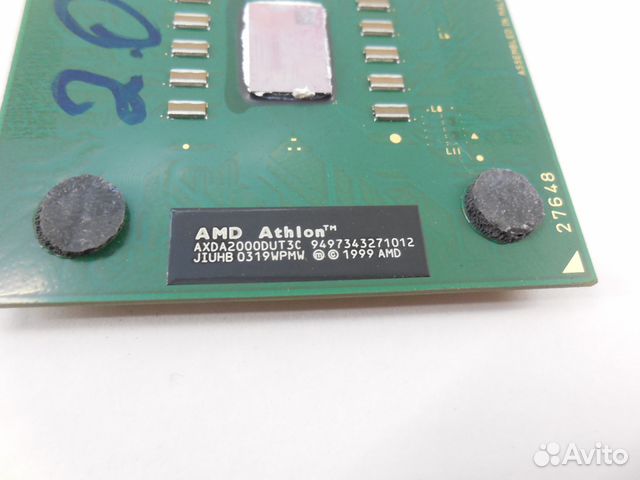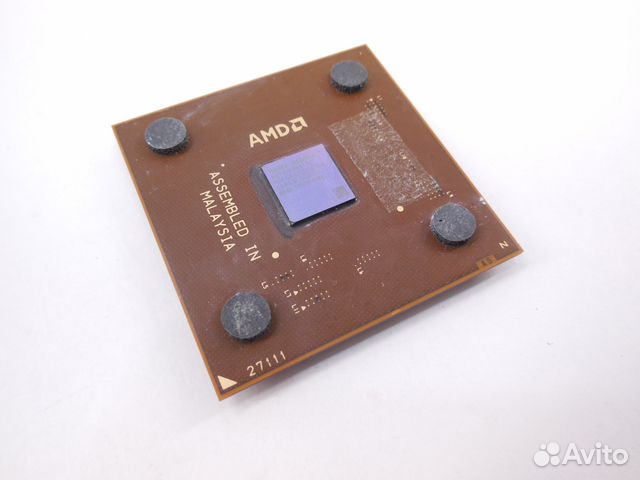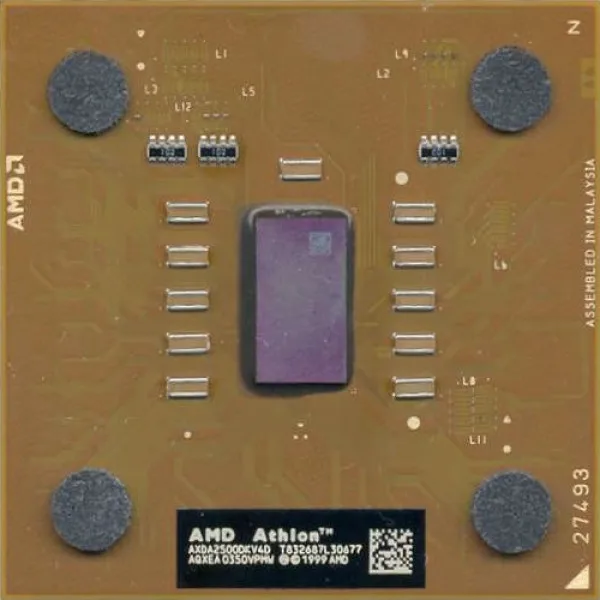Socket 462 or Socket A (AMD)
Socket A is the socket that took over from Slot A (AMD’s version of Slot 1, which used the same connector incompatibly by turning it upside down). It hosted AMD Athlon, Athlon XP, Athlon MP, Duron and Sempron CPUs. It was the socket of AMD’s heyday, and was widely praised for remaining constant despite several generational improvements, through the use of increased FSB rates. The CPUs were initially built using ceramic packages, similar to the K6 series, however, later transitioned to an Organic PGA package which was probably cheaper to produce.
AMD Duron D800AUT1B 800Mhz
This was an 800Mhz CPU with the Spitfire core, based on the Athlon Thunderbird design. The Duron name was intended to compete with the Intel Celeron, but was later retired in favour of Sempron. Note the existence of numbered L* jumpers on the top of the chip – some enthusiasts found that bridging certain points allowed unlocking cache, and multipliers for overclocking and painted over these points with conductive paint to do so!
AMD Athlon A1333AMS3C 1333Mhz
The real deal with all the cache and clock to go with it, this is a Thunderbird based Athlon.
AMD Duron DHD1200AMT1B 1200Mhz
This Duron is based on the Morgan core, which itself is based on the Palomino core. This is what happens to a highly abused chip that wasn’t shipped or mounted with care – note how the die is severely chipped on all sides. Trust me, I didn’t do this – I’m not that hamfisted!
AMD Athlon MP AHX1200AMS3C 1200Mhz
The Athlon MP series were designed for Multi-Processor systems, however, I found that in most Socket A motherboards, it would misidentify but still operate correctly. Athlon MP motherboards cannot use Athlon/Athlon XP CPUs however. This particular CPU was based on the Palomino design, which succeeded the Thunderbird.
AMD Athlon XP 1800+ AX1800DMT3C 1533Mhz
Another CPU based on the Palomino core, although in an organic PGA package rather than the ceramic PGA package above.
AMD Athlon XP 2000+ AX2000DMT3C 1667Mhz
A faster version of the one above.
AMD Athlon MP 2000+ AMP2000DMS3C 1667Mhz
This is the MP version of the above.
AMD Athlon XP 2400+ SDA2400DUT3D 1667Mhz
This chip uses the Thoroughbred-B core design, which succeeds the Thoroughbred-A core shrink of the Palomino core design that the prior CPUs used. And yes, they did use an amber/orange substrate.
AMD Athlon XP 2500+ AXDA2500KV4D 1833Mhz
This is a Barton core CPU, one of the last generations of designs for Socket A, which was supplanted by Socket 754 and 939. Definitely one of the favourites with the overclockers.
AMD Athlon XP 2800+ AXDA2800DKV4D 2083Mhz
This is another Barton core, despite the different colouration. You can distinguish it from the shape of the die itself. As a CPU that has been mounted many many times over, the pads which help prevent die edge cracking have started to decompose.
What Is a Socket 462 Motherboard? (with pictures)
`;
Internet
Fact Checked
Andy Josiah
A Socket 462 motherboard is a motherboard that has a central processing unit (CPU) socket from semiconductor company Advanced Micro Devices (AMD) called Socket 462, or Socket A. This is a socket that physically supports an AMD processor, or CPU, as well as connects it with the motherboard for data transmission. Functioning as the “heart” of a personal computer (PC), the Socket 462 motherboard also contains several other essential components. It uses the microATX (Advanced Technology eXtended) form factor, which has a maximum size standard of 9.6 square inches (244 square mm) and a minimum size standard of 6.75 square inches (171.45 square mm). Manufacturers of the motherboard include ASUSTeK Computer Incorporated (ASUS), Micro-Star International (MSI) and Hewlett-Packard (HP).
This is a socket that physically supports an AMD processor, or CPU, as well as connects it with the motherboard for data transmission. Functioning as the “heart” of a personal computer (PC), the Socket 462 motherboard also contains several other essential components. It uses the microATX (Advanced Technology eXtended) form factor, which has a maximum size standard of 9.6 square inches (244 square mm) and a minimum size standard of 6.75 square inches (171.45 square mm). Manufacturers of the motherboard include ASUSTeK Computer Incorporated (ASUS), Micro-Star International (MSI) and Hewlett-Packard (HP).
AMD introduced Socket 462 in 2000 for entries of four of its processor brands. They are the Athlon, which was the company’s flagship brand at the time; Duron, which was AMD’s low-budget chip; Sempron, which succeeded Duron in 2004; and the embedded system-geared Geode NX. Operating on a voltage range of 1 to 2.05-volt (V), the socket on the Socket 462 motherboard supports CPUs from the aforementioned brands that combine for a processing speed range of 650 to 2,333 megahertz (MHz). The supported data transmission speeds are 200, 266, 333 and 400 megatransfers per second (MT/s). This translates to 200, 266, 333 and 400 million transfers per second.
They are the Athlon, which was the company’s flagship brand at the time; Duron, which was AMD’s low-budget chip; Sempron, which succeeded Duron in 2004; and the embedded system-geared Geode NX. Operating on a voltage range of 1 to 2.05-volt (V), the socket on the Socket 462 motherboard supports CPUs from the aforementioned brands that combine for a processing speed range of 650 to 2,333 megahertz (MHz). The supported data transmission speeds are 200, 266, 333 and 400 megatransfers per second (MT/s). This translates to 200, 266, 333 and 400 million transfers per second.
Socket 462 is named after its 462 pin holes, which accommodate the processor’s pins. These are arranged in an orderly four-row layout on a 2.2-by-2.58-inch (5.59-by-6.55-centimeter) square-shaped substrate, with a section cut out of the middle. This chip form factor is known as pin grid array (PGA), and it comes in either of two variants, depending on the kind of material used to make the structure. Ceramic pin grid array (CPGA) means that it is made of ceramic, while the organic pin grid array (OPGA) term is used for an organic-plastic manufacture. A zero insertion force (ZIF) feature is included for the complete elimination of force when inserting or removing the PC chip.
These are arranged in an orderly four-row layout on a 2.2-by-2.58-inch (5.59-by-6.55-centimeter) square-shaped substrate, with a section cut out of the middle. This chip form factor is known as pin grid array (PGA), and it comes in either of two variants, depending on the kind of material used to make the structure. Ceramic pin grid array (CPGA) means that it is made of ceramic, while the organic pin grid array (OPGA) term is used for an organic-plastic manufacture. A zero insertion force (ZIF) feature is included for the complete elimination of force when inserting or removing the PC chip.
Besides the socket, the Socket 462 motherboard has other important components. The dual inline memory module (DIMM) sockets are for storing the PC’s random-access memory (RAM). Serial advanced technology attachment (SATA) and integrated drive electronics (IDE) interfaces are for connecting hard drive and optical drives. Peripheral component interconnect (PCI) and accelerated graphics port (AGP) slots serve as expansion slots for components such as graphics processing units (GPU) to improve the performance or capability of the PC. Other features of the Socket 462 motherboard include an Ethernet driver with a registered jack 45 (RJ45) for wired networking, a sound driver with headphone and microphone jacks for audio, and a video graphics array (VGA) output for screen display.
The dual inline memory module (DIMM) sockets are for storing the PC’s random-access memory (RAM). Serial advanced technology attachment (SATA) and integrated drive electronics (IDE) interfaces are for connecting hard drive and optical drives. Peripheral component interconnect (PCI) and accelerated graphics port (AGP) slots serve as expansion slots for components such as graphics processing units (GPU) to improve the performance or capability of the PC. Other features of the Socket 462 motherboard include an Ethernet driver with a registered jack 45 (RJ45) for wired networking, a sound driver with headphone and microphone jacks for audio, and a video graphics array (VGA) output for screen display.
You might also Like
Recommended
AS FEATURED ON:
Socket 462 | this.
 .. What is Socket 462?
.. What is Socket 462?
Interpretation
- Socket 462
-
AMD
Socket A (also known as Socket 462 ) — socket for processors from Athlon Thunderbird to Athlon XP/MP 3200+ and for budget AMD Sempron processors, can also be used with Geode NX. Structurally, it is made in the form of a ZIF connector with 453 working contacts (9out of 462 contacts are blocked, but nevertheless the number 462 appears in the name). The system bus frequency for AMD Athlon XP and Sempron is 133, 166 and 200 MHz.
AMD recommended coolant weight for Socket A should not exceed 300g. Heavier coolers (coolers) can cause mechanical damage and cause system failure.
Technical specifications
- Supports processors from 600 MHz (Athlon XP 3400+).
- Operating Bus Frequency Doubling (data is transmitted on both clock edges) 100, 133, 166, and 200 MHz for Duron, Athlon XP, and
nine0032
Socket A Maximum Mechanical Load Limits
All processors used for this socket have a maximum mechanical load limit (shown in the table below).
 If these standards are not observed, mechanical damage and system failure are possible.
If these standards are not observed, mechanical damage and system failure are possible. Regulation Dynamic loads Static loads Surface 445H 133H Edges 44H 44H The limits given here are much stricter than those for Socket 478 processors. Most Socket A processors do not have a protective metal casing, so there is a very high chance of mechanical damage to the processor die when installing/removing the processor cooler. Special care must be taken when using non-standard, homemade, and non-AMD approved cooling solutions. nine0003
PC processor sockets Intel Socket 1 • Socket 2 • Socket 3 • Socket 4 • Socket 5 • Socket 6 • Socket 7 • Socket 8 • Socket 370 • Socket 423 • Socket 478 • Socket 479 • Socket 480 • Socket 603/604 • Socket J (LGA 771 ) • Socket T (LGA 775 • LGA1160 • LGA1366) • Socket M • Slot 1 • Slot 2
AMD Super Socket 7 • Slot A • Socket A (Socket 462) • Socket 563 • Socket 754 • Socket 939 • Socket 940 • Socket AM2 • Socket AM2+ • Socket F (Socket 1207) • Socket S1
Wikimedia Foundation.

